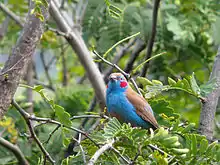Uraeginthus
Uraeginthus is a genus of small seed-eating birds in the family Estrildidae that are found in Sub-Saharan Africa.
| Uraeginthus | |
|---|---|
 | |
| Red-cheeked cordon-bleu (Uraeginthus bengalus) | |
| Scientific classification | |
| Domain: | Eukaryota |
| Kingdom: | Animalia |
| Phylum: | Chordata |
| Clade: | Dinosauria |
| Class: | Aves |
| Order: | Passeriformes |
| Family: | Estrildidae |
| Genus: | Uraeginthus Cabanis, 1851 |
| Type species | |
| Fringilla bengalus[1] Linnaeus, 1766 | |
The genus was introduced by the German ornithologist Jean Cabanis in 1851.[2] The type species was subsequently designated as the red-cheeked cordon-bleu.[3] The name Uraeginthus combines the Ancient Greek words oura "tail" and aiginthos for an unknown bird, perhaps a finch.[4]
It contains the following three species:[5]
| Image | Scientific name | Common Name | Distribution |
|---|---|---|---|
.jpg.webp) | Uraeginthus angolensis | Blue waxbill | from Cabinda and the Congo to Kenya and Tanzania in the east south to northern South Africa |
_male.jpg.webp) | Uraeginthus bengalus | Red-cheeked cordon-bleu | Ethiopia, Uganda, Kenya, Tanzania, Angola, south Democratic Republic of the Congo and north Zambia |
_2_(44771771850).jpg.webp) | Uraeginthus cyanocephalus | Blue-capped cordon-bleu | Ethiopia, Kenya, Somalia, South Sudan, and Tanzania in East Africa |
References
- "Estrildidae". aviansystematics.org. The Trust for Avian Systematics. Retrieved 2023-07-16.
- Cabanis, Jean; Heine, Ferdinand (1851). Museum Heineanum : Verzeichniss der ornithologischen Sammlung des Oberamtmann Ferdinand Heine, auf Gut St. Burchard vor Halberstadt (in German and Latin). Vol. 1. Halberstadt: R. Frantz. p. 171.
- Paynter, Raymond A. Jr, ed. (1968). Check-list of birds of the world. Vol. 14. Cambridge, Massachusetts: Museum of Comparative Zoology. pp. 331–332.
- Jobling, J.A. (2018). del Hoyo, J.; Elliott, A.; Sargatal, J.; Christie, D.A.; de Juana, E. (eds.). "Key to Scientific Names in Ornithology". Handbook of the Birds of the World Alive. Lynx Edicions. Retrieved 4 May 2018.
- Gill, Frank; Donsker, David; Rasmussen, Pamela, eds. (July 2021). "Waxbills, parrotfinches, munias, whydahs, Olive Warbler, accentors, pipits". IOC World Bird List Version 11.2. International Ornithologists' Union. Retrieved 13 July 2021.
Wikimedia Commons has media related to Uraeginthus.
This article is issued from Wikipedia. The text is licensed under Creative Commons - Attribution - Sharealike. Additional terms may apply for the media files.